The SSD Anthology: Understanding SSDs and New Drives from OCZ
by Anand Lal Shimpi on March 18, 2009 12:00 AM EST- Posted in
- Storage
PCMark Vantage
Next up is PCMark Vantage, another system-wide performance suite. For those of you who aren’t familiar with PCMark Vantage, it ends up being the most real-world-like hard drive test I can come up with. It runs things like application launches, file searches, web browsing, contacts searching, video playback, photo editing and other completely mundane but real-world tasks. I’ve described the benchmark in great detail before but if you’d like to read up on what it does in particular, take a look at Futuremark’s whitepaper on the benchmark; it’s not perfect, but it’s good enough to be a member of a comprehensive storage benchmark suite. Any performance impacts here would most likely be reflected in the real world.
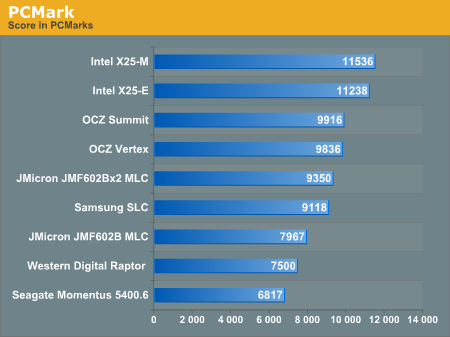
If you've paid attention to the synthetic tests from the previous pages, the results here should make sense. The Intel drives take the top two spots followed by the two OCZ drives, then the JMicron and conventional HDDs take up the rear.
While PCMark does do a great job of measuring disk performance, it doesn't seem to stress random write performance as much, allowing the JMicron drives to relax a bit.
Now let's look at the individual test suites:
The memories suite includes a test involving importing pictures into Windows Photo Gallery and editing them, a fairly benign task that easily falls into the category of being very influenced by disk performance.
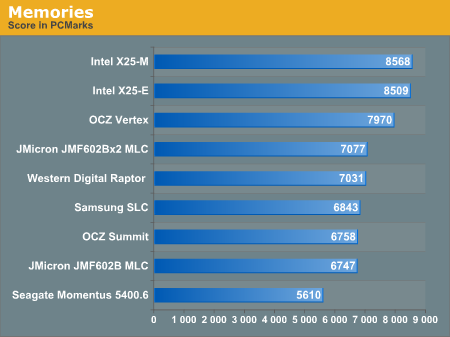
The TV and Movies tests focus on on video transcoding which is mostly CPU bound, but one of the tests involves Windows Media Center which tends to be disk bound.
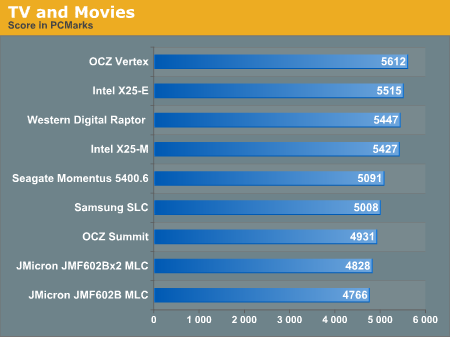
SSDs won't always dominate and in many cases they won't offer tangible improvements over a fast hard drive.
The gaming tests are very well suited to SSDs since they spend a good portion of their time focusing on reading textures and loading level data. All of the SSDs dominate here, but as you'll see later on in my gaming tests the benefits of an SSD really vary depending on the game. Take these results as a best case scenario of what can happen, not the norm.
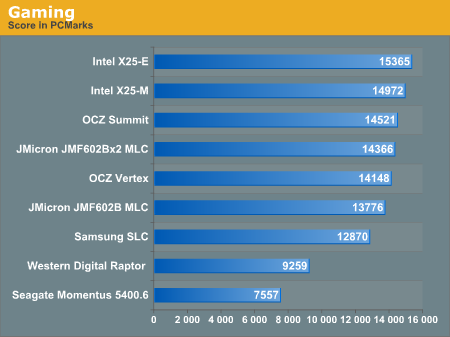
In the Music suite the main test is a multitasking scenario: the test simulates surfing the web in IE7, transcoding an audio file and adding music to Windows Media Player (the most disk intensive portion of the test).
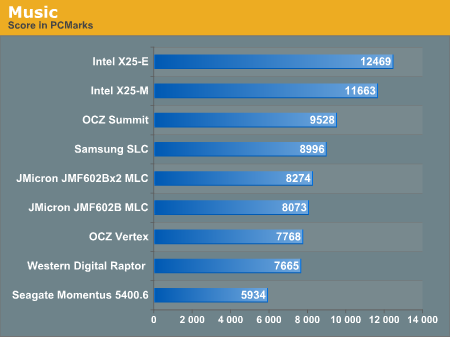
The Communications suite is made up of two tests, both involving light multitasking. The first test simulates data encryption/decryption while running message rules in Windows Mail. The second test simulates web surfing (including opening/closing tabs) in IE7, data decryption and running Windows Defender.
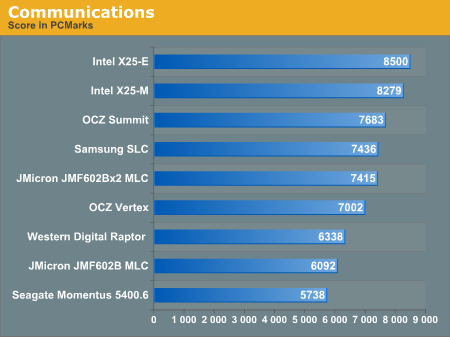
I love PCMark's Productivity test; in this test there are four tasks going on at once, searching through Windows contacts, searching through Windows Mail, browsing multiple webpages in IE7 and loading applications. This is as real world of a scenario as you get and it happens to be representative of one of the most frustrating HDD usage models - trying to do multiple things at once. There's nothing more annoying than trying to launch a simple application while you're doing other things in the background and have the load take seemingly forever.

The results here are the best characterization of my personal experience with the drives. The Intel drives are the fastest, a good 25% faster than the Summit or Vertex. Next up are the OCZ drives, with the Vertex dangerously close to the Summit. The older Samsung SLC is next in the standings, followed by the JMicron drives. There's a healthy combination of reads and writes going on here which benefits all of the SSDs, including the less desirable ones.
The final PCMark Vantage suite is HDD specific and this is where you'll see the biggest differences between the drives:
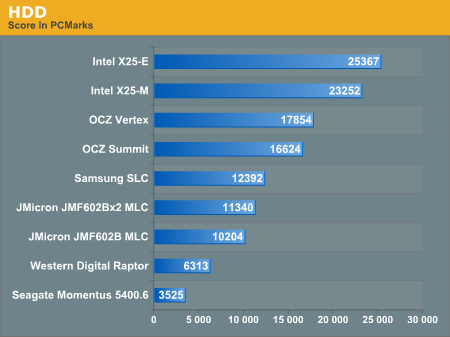
Again we're seeing the sort of breakdown we'd expect. The Intel drives come out ahead, while the Vertex is the best bang for your buck.










250 Comments
View All Comments
SkullOne - Wednesday, March 18, 2009 - link
Fantastic article. Definitely one of the best I've read in a long time. Incredibly informative. Everyone who reads this article is a little bit smarter afterwards.All the great information about SSDs aside, I think the best part though is how OCZ is willing to take blame for failure earlier and fix the problems. Companies like that are the ones who will get my money in the future especially when it is time for me to move from HDD to SSD.
Apache2009 - Wednesday, March 18, 2009 - link
i got one Vertex SSD. Why suspend will cause system halt ? My laptop is nVidia chipset and it is work fine with HDD. Somebody know it ?MarcHFR - Wednesday, March 18, 2009 - link
Hi,You wrote that there is spare-area on X25-M :
"Intel ships its X25-M with 80GB of MLC flash on it, but only 74.5GB is available to the user"
It's a mistake. 80 GB of Flash look like 74.5GB for the user because 80,000,000,000 bytes of flash is 74.5 Go for the user point of view (with 1 KB = 1024 byte).
You did'nt point out the other problem of the X25-M : LBA "optimisation". After doing a lot of I/O random write the speed in sequential write can get down to only 10 MB /s :/
Kary - Thursday, March 19, 2009 - link
The extra space would be invisible to the end user (it is used internally)Also, addressing is normally done in binary..as a result actual sizes are typically in binary in memory devices (flash, RAM...):
64gb
128gb
80 GB...not compatible with binary addressing
(though 48GB of a 128GB drive being used for this seems pretty high)
ssj4Gogeta - Wednesday, March 18, 2009 - link
Did you bother reading the article? He pointed out that you can get any SSD (NOT just Intel's) stuck into a situation when only a secure erase will help you out. The problem is not specific to Intel's SSD, and it doesn't occur during normal usage.MarcHFR - Wednesday, March 18, 2009 - link
The problem i've pointed out has nothing to do with the performance dregradation related to the write on a filled page, it's a performance degradation related to an LBA optimisation that is specific to Intel SSD.VaultDweller - Wednesday, March 18, 2009 - link
So where would Corsair's SSD fit into this mix? It uses a Samsung MLC controller... so would it be comparable to the OCZ Summit? I would expect not since the rated sequential speeds on the Corsair are tremendously lower than the Summit, but the Summit is the closest match in terms of the internals.kensiko - Wednesday, March 18, 2009 - link
No, OCZ Summit = newest Samsung controller. The Corsair use the previous controller, smaller performance.VaultDweller - Wednesday, March 18, 2009 - link
So what's the difference?The Summit is optimized for sequential performance at the cost of random I/O, as per the article. That is clearly not the case with the Corsair drive, so how does the Corsair hold up in terms of random I/O? That's what I'm interested in, since the sequential on the Corsair is "fast enough" if the random write performance is good.
jatypc - Wednesday, March 18, 2009 - link
A detailed description of how SSDs operate makes me wonder: Imagene hypothetically I have a SSD drive that is filled from more than 90% (e.g., 95%) and those 90% are read-only things (or almost read-only things such as exe and other application files). The remaining 10% is free or frequently written to (e.g., page/swap file). Then the use of drive results - from what I understood in the article - in very fast aging of those 10% of the SSD disk because the 90% are occupied by read-only stuff. If the disk in question has for instance 32GB, those 10% are 3.2 GB (e.g., a size of a usual swap file) and after writing it approx. 10000 times, the respective part of the disk would become dead. Being occupies by a swap file, this number of reads/writes can be achieved in one or two years... Am I right?